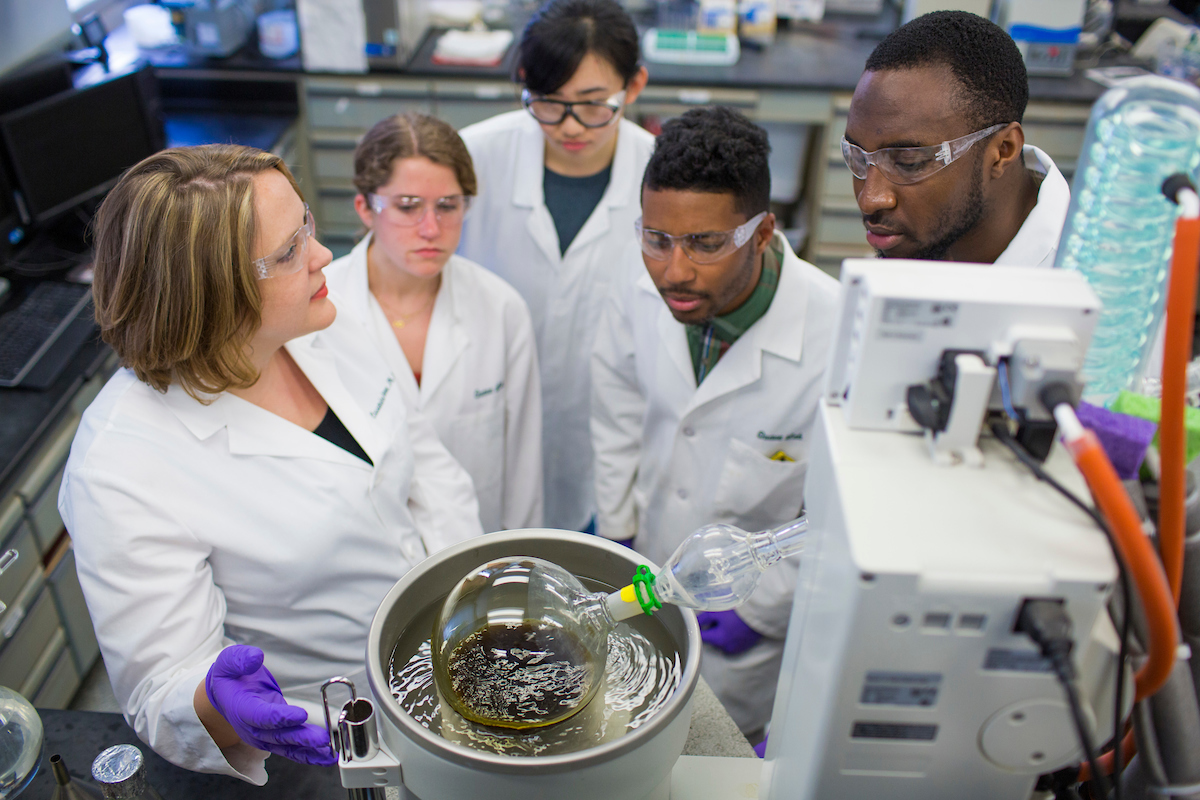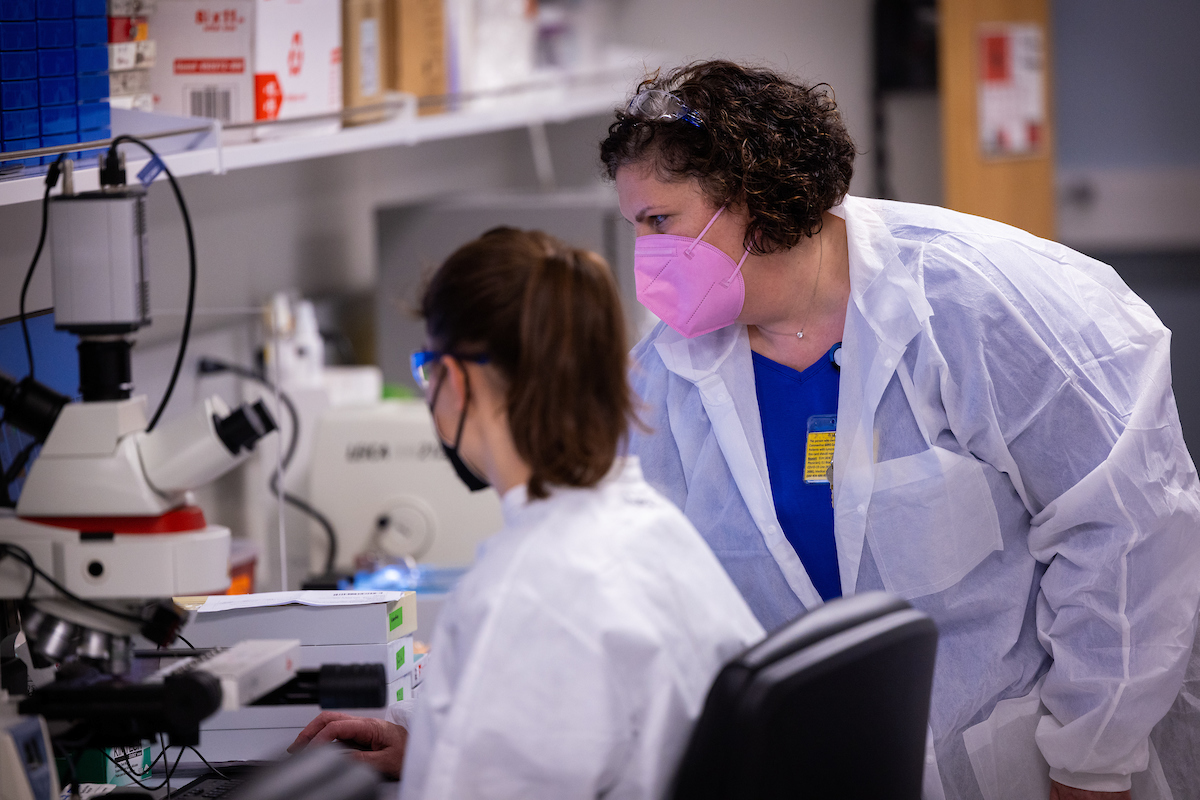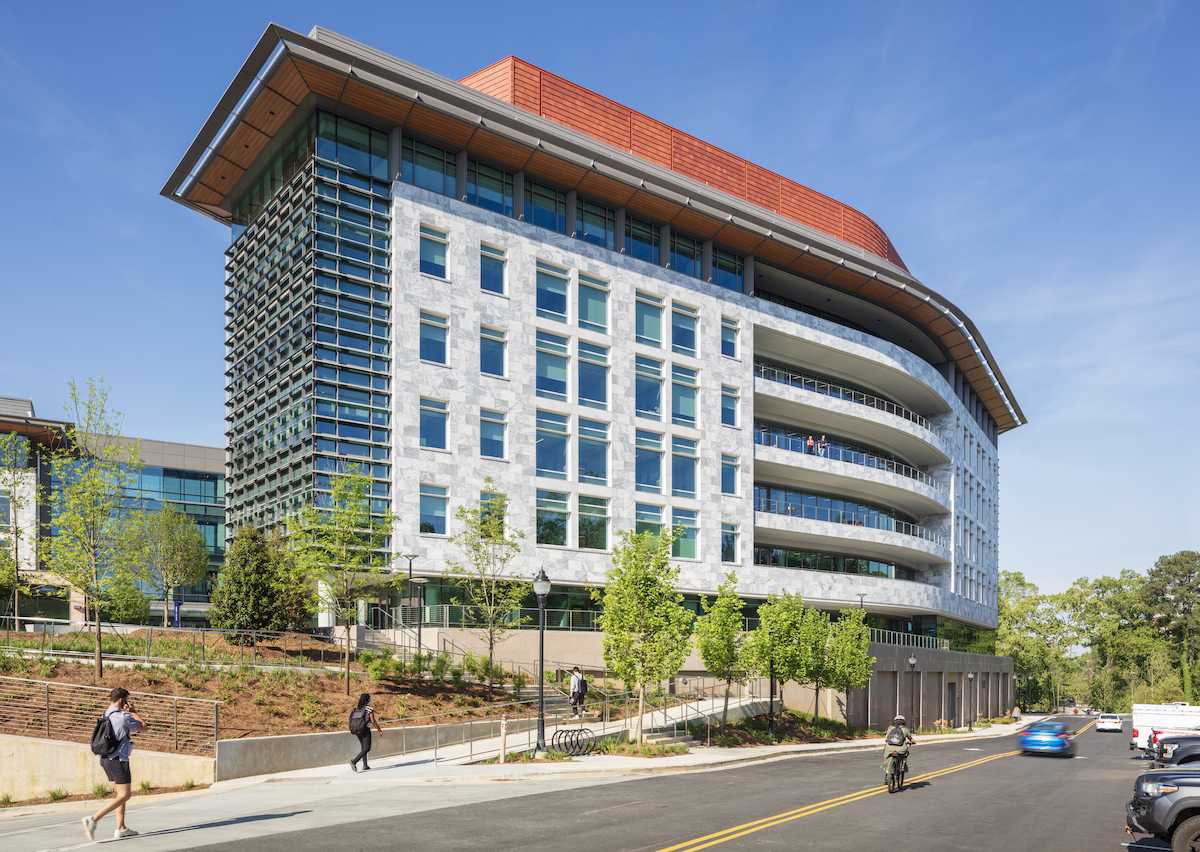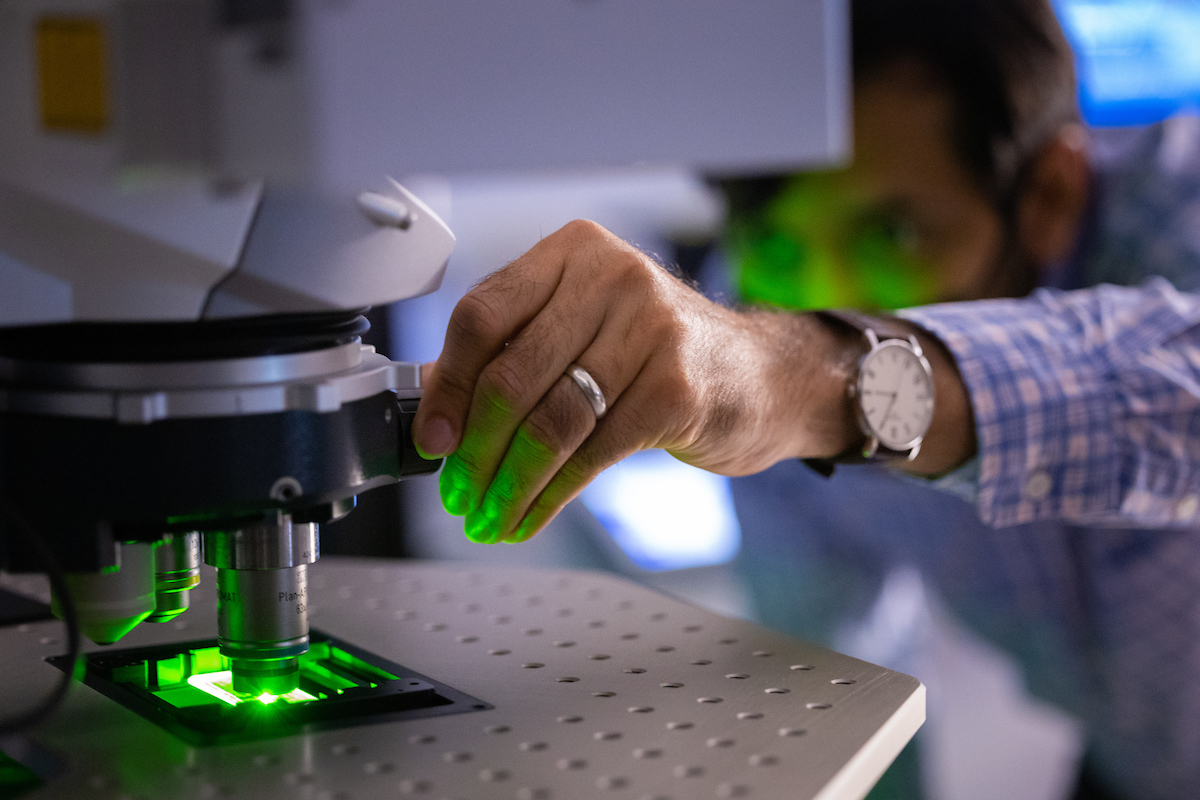Did you know there is a common link between novel mechanisms for alleviating pain after spinal cord injury, insights into what environmental chemicals trigger weight gain, and advancements in rare neurodevelopmental disorder research?
The Emory Integrated Core Facilities (EICF) has played a pivotal role in facilitating these incredible discoveries and more. Thanks to the EICF, researchers like Sandra Garraway, PhD, associate professor, Department of Cell Biology, Victor Corces, PhD, professor, Department of Human Genetics, and Victor Faundez, MD, PhD, professor, Department of Cell Biology, have revealed valuable insights that drive meaningful outcomes.
The EICF are research hubs featuring 19 distinct research cores, each with different offerings. They empower and partner with researchers to push the boundaries of knowledge and unravel the mysteries of science. With a steadfast commitment to research excellence, the EICFs harness their collective expertise and resources to drive multidisciplinary collaboration and foster scientific discovery.
Imagine you are a researcher who needs access to MRI technology. The Center for Systems Imaging Core can connect you to Georgia’s first 7T MRI. Or imagine you want to leverage technology and algorithms to make data-driven decisions about patient care. The Medical Imaging, Informatics, and AI Core can help you collect, organize, and analyze complex information from x-rays, scans, and tests. And that’s just scratching the surface of the services the cores provide research investigators.
Partnership in action
The cores are purpose-built to streamline the process of collaboration. The EICF makes it easier for investigators to collaborate and create bench-to-bedside innovations that transform outcomes. “We are very pleased with the state-of-the-art professional transgenic services provided by Emory Mouse Transgenic and Gene Targeting Core,” says Devesh Pant, PhD, MSc, an instructor in the Department of Cell Biology who relies on the EICF.
The cores are also a doorway to enhancing research and the breadth of collaboration. Thanks to a Georgia Core Facilities Partnership, supported by the Georgia Research Alliance’s Georgia Core Exchange website and database, investigators using EICF can also access the core facilities at Georgia's eight largest research universities.
Lyra Griffiths, PhD, associate scientist and director of the Emory Integrated Genomics Core (EIGC), praises the collaborative spirit of the cores, noting, “Within a few miles, we have incredible access to resources from Emory National Primate Research Center, Winship Cancer Institute, the School of Medicine, and more.”

“The Integrated Core Facilities are key to Emory’s research excellence,” remarks Adam Marcus, PhD, Emory’s associate VP for research and associate dean of research cores and novel technologies. Marcus emphasizes the importance of the incredible scope of research success the EICF has contributed to, saying, “Supporting 450 unique laboratories at Emory and beyond underscores the importance of our mission to find meaningful breakthroughs."
Cassandra Quave, PhD, assistant dean of research cores, echoes Marcus, saying, “It’s really exciting to see the incredible impact that the EICF has had on the research mission of the university.”
A guiding light for institutions
The cores began as a few passionate researchers pooling their resources to tackle big scientific challenges. This humble collaboration quickly ballooned into campus-wide pillars of support for innovation. In recent years, Emory has accelerated their investment in EICF, resulting in impressive outcomes for scientists and researchers.
Whether you’re a principal investigator (PI), a physician, or a graduate student, you can find access to the tools you need at the EICF. For example, Ofer Sadan, MD, PhD, assistant professor in the Department of Neurology, researches how medicine injected into the brain’s ventricles moves through the cerebrospinal fluid. Sadan assesses how quickly it takes for the medicine to affect the area, where it goes once it’s there, how long it stays in the area, and how the body gets rid of the medicine after it’s done its job.

Sadan praises the cores, saying, “The EICF, especially the HPLC Bioanalytical Core, has been crucial. It spared us from buying expensive equipment or hiring experts, as we can access world-class professionals. With their help, we developed a complex model for the drug's behavior, which is not commonly studied.”
Another notable example of excellence through the cores occurred last year when Emory was chosen as the host site for the Southeastern Association of Shared Resources (SEASR) conference, underscoring its reputation for excellence in biomolecular research and innovation. "EICF’s structure has become the guiding light for institutions, "says Pritha Bagchi, PhD, associate director of the Emory Integrated Proteomics Core (EIPC). “Leadership at Emory is so supportive of developing the cores that we have become the standard bearer for how to run a successful core. Other institutions see our model and are inspired by it.”
Fueling discovery by supporting investigators
Interdisciplinary collaboration is essential for advancing our understanding of disease etiology, risk factors, and preventative strategies. While there is ample opportunity for faculty to leverage these resources, navigating them can be daunting. Recognizing this, the EICF has developed a comprehensive brochure that catalogs its offerings in one centralized location.
Access to the EICF equips investigators with tools that are not typically accessible and used in their research specialties. “A lot of the technologies in these innovation cores are available in engineering research labs,” says Wilbur Lam, MD, PhD, W. Paul Bowers Research Chair in the Department of Pediatrics, professor in the Wallace H. Coulter Department of Biomedical Engineering, associate dean of innovation for Emory University School of Medicine, and chief innovation officer for Children's Healthcare of Atlanta Pediatric Technology Center.
“We are doing what no medical school has ever done—making this technology available to our medical researchers as well as to our entire scientific community.” - Wilbur Lam
Lam adds, “We are doing what no medical school has ever done—making this technology available to our medical researchers as well as to our entire scientific community.”
For example, epidemiologists typically don't require stem cell technology in their research endeavors. However, through the Emory Stem Cell Core (ESCC), epidemiologists can readily access pluripotent stem cells, enabling them to delve into the study of infectious diseases in novel ways. Armed with stem cells, epidemiologists can thoroughly investigate the underlying mechanisms of disease transmission, host-pathogen interactions, and potential therapeutic interventions.
Breaking ground for better outcomes
Less than a year ago, the Health Sciences Research Building II (HSRB-II) opened on Emory’s campus. This landmark facility is a cutting-edge space where researchers collaborate to solve the most complex human health problems. HSRB-II construction was funded by a $200 million gift from the Robert W. Woodruff Foundation as part of a total $400 million gift to Emory University in 2018—the largest gift in the history of the 187-year-old university. HSRB-II includes an Animal/Biosafety Level 3 (A/BSL3) lab that features state-of-the-art equipment like centrifuges, water baths, scopes, flammable cabinets and more.
The Emory Integrated Core Facilities are a big part of the HSRB’s mission. The HSRB houses the core facilities for advanced imaging (7-T MRI), Flow Cytometry, Integrated Cellular Imaging, Gnotobiotic Animal, Mouse Transgenic & Gene Targeting, Rodent Behavioral, Genomics, and Metabolomics & Lipidomics Cores.

The HSRB-II is also home to the new Emory Integrated Biorepository Core (EIBC), which includes a fully-automated Hamilton BiOS M7 -80 C biorepository freezer storage. Investigators can use the EIBC to track and retrieve biospecimens.
Reflecting on the importance of the core facilities in HSRB, Adam Marcus, says “Core facilities provide cutting-edge technologies to collaboratively support impactful research. Equipment in cores is generally not found in an individual lab since it is either too expensive or difficult to maintain.”
Investment in technology
Emory University has always been an innovation hub. Having access to cutting-edge technology is vital to fueling discovery.
In 2024 the School of Medicine has budgeted $6,235,381 in subsidy support for the cores along with $500,000 in capital equipment funding. Lisa Carlson, MPH, MCHES, senior executive administrator, Research Administration for Emory School of Medicine, observes, “The School of Medicine has grown core and Division of Animal Resources (DAR) support, particularly over the last couple of years with increases in both capital and subsidy investments.”
Indeed, the DAR was budgeted $1,100,000 in subsidy support and $450,000 in capital equipment funding. DAR currently supports a research portfolio of over $200M and encompasses 202,504 square feet.
“The School of Medicine has grown core and Division of Animal Resources (DAR) support, particularly over the last couple of years with increases in both capital and subsidy investments.” - Lisa Carlson
Michael Huerkamp, DVM, DACLAM, director of the Division of Animal Resources—and recent recipient of a lifetime achievement award—praises these figures, saying, " These investments in the DAR have enabled a broader array of projects from outdoor research to highly contained state-of-the-art aquatic facilities with robotic feeding and automated water treatment; a variety of flexible and adaptable spaces to accommodate a multitude of PI-selected imaging and in vivo phenotyping machines and devices critical to contemporary research.”
Huerkamp emphasizes how strategic investment in technology and people enable scientists to lead in their respective fields, “with improved monitoring and control of environmental variables to promote consistent environmental conditions so that our that scientists can conduct experiments confident of their validity.”
He adds, “Labor-saving automation allows our professional staff to concentrate on what really matters: taking care of the animals, meeting the needs of our scientists, and taking care of each other in pursuit of those first two objectives."

The integration of cutting-edge technologies illustrates Emory’s commitment to enhancing research capabilities. For example, the new 7T MRI allows researchers to create images that have high resolution, enhanced tissue, contrast, and a wider variety of research applications in addition to breakthrough imaging processes like using MRE imaging to diagnose neurological conditions. Emory is the first in Georgia to have access to 7T MRI.
These technologies assist neuroscience researchers in gaining deeper insights into the fundamental mechanisms of diseases, facilitating the development of enhanced therapeutic interventions.
Candace C Fleischer, PhD, director of Emory’s Fleischer Biomedical Spectroscopy and Imaging Laboratory (BSIL) and associate professor in the Department of Radiology and Imaging Sciences. Fleischer credits access to the 7T MRI as crucial for her lab’s research. "Our lab is focused on developing new tools and markers using advanced biomedical imaging to study both healthy and injured brains,” Fleischer says. Adding, “The 7T MRI is instrumental to our goals.”
A Commitment to driving discovery
Over the next year, EICF leadership will continue to enhance services and technology and foster collaboration to drive continued discovery across basic, translational, and clinical sciences.
Last year, EICF hosted its first-ever Core Directors Retreat to review strategic pillars, envision research goals, and review feedback from core users. 47 leaders at the retreat shared innovations and engaged in meaningful dialogues. The retreat culminated with an inaugural EICF Annual Awards Ceremony, where key members of the EICF received recognition for outstanding service and performance.
"Emory's commitment to research excellence is exceptional—and our integrated core facilities serve as one major driving force" - Adam Marcus
“Emory's commitment to research excellence is exceptional—and our integrated core facilities serve as one major driving force,” says Marcus. He emphasizes that the EICF's excellent achievements are a direct result of the invaluable contributions of its people.
In the past year alone, the EICF facilitated groundbreaking discoveries across 450 unique laboratories, touching on diverse fields from neuroscience to epidemiology. This record-breaking achievement emphasizes how vital the cores are to investigators—and how much our investigators rely on the cores to drive discovery.


